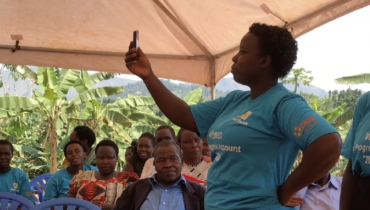As the pace at which international migration occurs has accelerated during the current phase of globalization, so has the feminization of migration. That is to say, women constitute a growing part of international migration movements, increasingly migrating on their own and as the main economic providers of their households, rather than merely as wives or dependents who follow their husbands.
As a result of the growing number of female migrants, there has been an increase in the share of remittances – the money earned by migrants working abroad that is sent back home – both sent and received by women, and both in the destination and origin countries. Remittances have the potential to transform the economic role of women, within the household and the larger community. Nevertheless, the empowerment potential of remittances is constrained by existing gender roles, as well as conditions in the destination and origin countries that affect women’s legal and employment status. In order to fully understand the impact of remittances on the economic empowerment of women, it is necessary to examine the opportunities remittances offer, as well as the limitations they face.
Remittances and Economic Empowerment
Migration, and subsequently the flow of remittances, can increase women’s economic opportunities by giving them greater control over household finances and, therefore, greater decision-making power. This is true of migrant women who, by sending remittances, acquire a role as the primary earner for their families, as well as women who remain in the country of origin and, by receiving remitted money, gain greater responsibility over household expenditures. According to the International Organization for Migration, remittances serve to provide women greater inclusion in household financial decision-making processes, and households as a whole benefit because women tend to spend remitted money on the nutritional, educational and healthcare needs of household members, especially children; men tend to allocate a larger proportion of remittances to investments.
Remittances have the potential to transform the role of women within their households and communities, but this potential is often constrained by other factors. For one, the impact of remittances is dependent on the initial conditions of migration. Although it is true that fewer women migrate as dependents of their spouses, this does not imply that most female migration is entirely autonomous. An increasing percentage of women migrate in order to sustain their families. In this sense, migration occurs as a household survival strategy, with many women leaving because they have been forced to assume the role of the family’s main economic provider.
Of course, the search for better economic opportunities is not the only reason why women migrate; involuntary migration may also occur as a result of war or civil unrest, displacement due to natural disaster or human trafficking.
Even when women do migrate with some degree of autonomy, expectations about the role of women derived from traditional gender relations often persist. This limits the effects that remittances have on women’s economic empowerment, and can even cause them to reinforce established gender roles. As stated in a report titled Crossing Borders: Remittances, Gender and Development by the UN International Research and Training Institute for the Advancement of Women, “the power hierarchies of gender within households play a crucial role in determining the dynamics of migrant families and social networks, which also influence the flows of remittances.” Women are typically expected to maintain intimate, long-lasting ties with family members; for women who have migrated, the expectation to continue caring for family can translate into a greater pressure to remit.
Indeed, a publication by UN Women titled Migration, Remittances, and Gender-Responsive Local Development shows that, across six developing countries, female migrants remit more frequently and consistently than do male migrants. Moreover, they send approximately the same amount of remittances as their male counterparts; however, because female migrants tend to earn less than male migrants, they are often sending a higher proportion of their income. Having little earnings left for themselves, women who face pressure to remit may be more likely to accept difficult living and working conditions.
The potential of remittances to increase female economic empowerment hinges greatly on the existing conditions of the environment, namely the legal status and employment opportunities for women in both the destination and origin countries. In the destination country, the legal environment influences remittance patterns because it affects migrants’ access to formal channels for banking and transferring money. This can act as a barrier to female migrants who lack proper documentation or who have migrated illegally. In addition, complex legal situations may prevent women from obtaining employment in the skilled formal sector; without a work permit they may be forced to find employment in the unskilled or informal sector, and are more likely to end up working in the domestic care and service industries, which can reinforce traditional gender roles. Likewise, in the origin country, the legal system determines whether women have access to resources such as credit or ownership of land, which in turn affects their ability to save and invest remitted money.
Harnessing the Economic Potential of Remittances
The central question is: how can we better harness the potential of remittances to empower rather than constrain women? To begin to address this question, we first look to a country where remittances play a large economic and social role, and where women contribute to a significant portion of remittance flows. Such is the case for Guatemala. According to the Pew Research Center, an inflow of more than $5.4 billion worth of remittances in 2013 accounted for nearly 10 percent of the country’s GDP, leading it to rank second among Latin American countries for the total amount of remittances received. Although female Guatemalan migrants currently constitute only one-fourth of remittance senders, approximately 63 percent of remittance recipients in Guatemala are women.
Migration among Guatemalan women has risen in recent years due to a combination of political instability and a lack of economic opportunity. Plagued by persistent socioeconomic problems, Guatemala has high levels of unemployment and underemployment, especially among women; this has resulted in large migration flows out of the country, as women who are the heads of their households seek better opportunities for their families. The remittances provided to and from Guatemalan women have been critical for the survival of individual households as well as the national economy.
In order to ensure that remittances promote greater economic freedom for women rather than increase their vulnerability, it is crucial to have safeguards in place to give control over remitted money directly to the women sending and receiving it. Additionally, these safeguards must be accompanied by public policies that reduce obstacles to women’s autonomy – in both the destination and origin countries – by ensuring their rights of association and labor, as well as their access to credit and land. One of the most common obstacles faced by Guatemalan female migrants, the majority of whom are undocumented, is their inability to access formal remittance channels due to a lack of proper documentation. As a result, many women are forced to remit through informal channels that charge large transfer fees, leaving them with even less in earnings with which to sustain themselves. A similar issue occurs in remittance-receiving countries. In Guatemala, for instance, only 10.1 percent of the remittance-receiving population uses formal banking services, with women accounting for 6.2 percent.
Potential Solutions
One possible solution to address this issue is to expand access for migrants to low-cost channels of money transfer, and increase transfer options outside of the traditional channels with strict documentation requirements. At the same time, solutions are needed that enhance women’s options for saving and investing smaller sums of money – especially when banks tend to exclude women from their services – in order to provide them with greater control over their finances. Informal organizations, such as self-help groups formed among women in the community, as well as larger microfinance institutions, can serve to improve women’s access to financial services and overall economic security. Even within the household, more can be done to give women equal decision-making power regarding remittance utilization, such as educational courses that equip them with practical financial skills and increase their confidence in decision-making.
Finally, migration policies need to incorporate a gender perspective, rather than continuing to overlook the specific context of women affected by migration. Acknowledging that women who migrate as their family’s main economic provider, as well as the women who remain behind as the heads of their households when their spouses migrate, are in a position of economic vulnerability is important, but it is equally necessary to recognize these women as powerful agents of change. Given the right tools, as well as the right environment in which to utilize these tools – namely one that provides savings opportunities, financial investment, education and social support – women can be empowered to make this change at the individual, household and community level.


